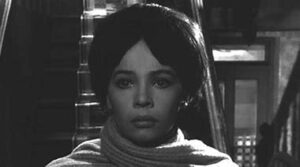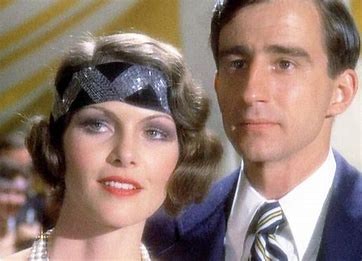Douglas Slocombe’s long and fruitful career can be divided into four stages.
Stage 1: The Master of Ealing
Dead of Night.
He was the cinematographer at Ealing Studios, where he worked with all five great Ealing directors on several classic movies and most of the Ealing comedies. One of his first was the still very frightening anthology horror “Dead of Night” (1945) and its climactic Alberto Cavalcanti-directed “Ventriloquist Dummy.”
The Lavender Hill Mob
Charles Crichton’s “Hue and Cry,” “The Titfield Thunderbolt,” and Ealing’s most successful film and only Oscar winner, “The Lavender Hill Mob” (for T. E. B. Clarke’s Original Screenplay).
Kind Hearts and Coronets
Robert Hamer’s most excellent film, “KH&C,” is Slocombe’s masterpiece from the Ealing era.
The Man in the White Suit
He also shot Alexander Mackendrick’s “The Man in the White Suit” and “Mandy” and Basil Dearden’s “The Captive Heart” and “Saraband for Dead Lovers.”

Stage 2: The Great British Cinematographer of the Sixties.
His stunning black and white cinematography on Bryan Forbes’ kitchen sink drama “The L-Shaped Room” with Leslie Caron and Joseph Losey’s “The Servant” with Dirk Bogart and James Fox, both from 1963, mark one of the high points of British cinema.

Stage 3: Cinematographer on the world stage.
He moved to the world stage after his first Oscar nomination at sixty for George Cukor’s “Travels with My Aunt” in 1972. During this period, his color cinematography on Jack Clayton’s underrated 1974 version of “The Great Gatsby” and Fred Zinnemann’s “Julia” (second Oscar nomination) are justly praised. Although the latter, which we now know was fabricated by its author, Lillian Hellman, has fallen out of favor, there is no denying the power of Slocombe’s autumnal and wintry mise-en-scene.

Stage 4: Indiana Jones
Finally, the Indiana Jones movies 1981, 1984, and 1989. His work on “Raiders of the Lost Ark” (third Oscar nomination), Spielberg’s most fantastic film, is excellent and alone, and it would grant him a place in the hall of cinema’s great cinematographers.
TABLE SUMMARY: CINEMATOGRAPHY BY DOUGLAS SLOCOMBE
| Year | My Rating | Film | Director | Awards for Douglas Slocombe and other notable facts. | Studio |
| EALING YEARS | |||||
| 1945 | A | Dead of Night* ** | Charles Crichton Alberto Cavalcanti Basil Dearden and Robert Hamer | Ealing Studios | |
| 1946 | C+ | The Captive Heart | Basil Dearden | Ealing Studios | |
| 1947 | B | Hue and Cry | Charles Crichton | Ealing Studios | |
| 1948 | C+ | Saraband for Dead Lovers | Basil Dearden | The first Ealing film to be shot in color. | Ealing Studios |
| 1949 | A+ | Kind Hearts and Coronets* | Robert Hamer | Ealing Studios | |
| 1951 | A | The Man in the White Suit* | Alexander Mackendrick | Ealing Studios | |
| 1952 | A | The Lavender Hill Mob* | Charles Crichton | Ealing Studios | |
| 1952 | B | Mandy | Alexander Mackendrick | Ealing Studios | |
| 1953 | B+ | The Titfied Thunderbolt | Charles Crichton | Ealing Studios | |
| BRITISH YEARS | |||||
| 1961 | C+ | The Young Ones | Sidney J.Furie | Paramount Pictures | |
| 1962 | B- | Freud* | John Huston | Universal-International | |
| 1963 | A- | The L-Shaped Room* | Bryan Forbes | British Lion Films | |
| 1963 | A | The Servant* | Joseph Losey | BAFTA Win BSC*** Win | Landau Releasing |
| 1965 | D+ | Guns at Batasi | John Guillermin | BAFTA Nominee | 20th Century Fox |
| 1967 | C- | The Blue Max | John Guillermin | BAFTA Nominee | 20th Century Fox |
| 1967 | C | The Fearless Vampire Killers | Roman Polanski | Metro-Goldwyn-Mayer | |
| 1968 | B- | The Lion in Winter | Anthony Harvey | BAFTA Nominee BSC Nominee | AVCO Embassy Pictures |
| 1969 | B | The Italian Job | Peter Collinson | Paramount Pictures | |
| 1970 | C | The Music Lovers | Ken Russell | United Artists | |
| 1971 | F | Slocombe had shot several scenes in “Close Encounters” uncredited. | Peter Yates | Paramount Pictures | |
| INTERNATIONAL YEARS | |||||
| 1972 | B- | Travels with My Aunt | George Cukor | BAFTA Nominee First Oscar Nomination | Metro-Goldwyn-Mayer |
| 1973 | B- | Jesus Christ Superstar | Norman Jewison | BAFTA Nominee BSC Win | Universal Pictures |
| 1974 | B | The Great Gatsby* | Jack Clayton | BAFTA Win BSC Win | Paramount Pictures |
| 1975 | C | Rollerball* | Norman Jewison | BAFTA Nominee | United Artists |
| 1975 | C | Hedda | Trevor Nunn | Bowden Productions Limited | |
| 1977 | B+ | Julia* (Second Oscar Nomination) | Fred Zinnemann | BAFTA Win BSC Win Second Oscar nomination LAFCA Win**** | 20th Century Fox |
| SPIELBERG YEARS | |||||
| 1977 | B | Close Encounters of the Third Kind | Steven Spielberg | Slocombe had shot several scenes for “Close Encounters” uncredited. | Columbia Pictures |
| 1981 | A+ | Raiders of the Lost Ark* | Steven Spielberg | BAFTA Nominee Third Oscar Nomination | Paramount Pictures |
| 1984 | C+ | Indiana Jones and the Temple of Doom | Steven Spielberg | BAFTA Nominee BSC Nominee | Paramount Pictures |
| 1989 | B- | Indiana Jones and the Last Crusade | Steven Spielberg | Paramount Pictures |
*Slocombe’s cinematography was singled out for special praise.
**An anthology horror film composed of individual segments: “The Hearse Driver” (Dearden), “The Christmas Party” (Cavalcanti), “The Haunted Mirror” (Hamer), “The Golfer’s Story” (Crichton), and the “Ventriloquist’s Dummy” (Cavalcanti). Dearden also directed the overarching story at the farmhouse.
***British Society of Cinematographers.
**** Los Angeles Film Critics Association.
https://thebrownees.net/1949-kind-hearts-and-coronets-30s-40s/
https://thebrownees.net/1963-the-l-shaped-room/


















